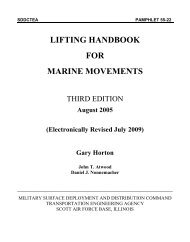Tiedown Handbook For Rail Movements - SDDCTEA - U.S. Army
Tiedown Handbook For Rail Movements - SDDCTEA - U.S. Army
Tiedown Handbook For Rail Movements - SDDCTEA - U.S. Army
Create successful ePaper yourself
Turn your PDF publications into a flip-book with our unique Google optimized e-Paper software.
SIXTH EDITION <strong>SDDCTEA</strong> PAMPHLET 55-19<br />
Section II. Wheeled Vehicles<br />
All wheeled vehicles must have their tires fully inflated to highway pressure for rail<br />
transport. The tires must be capable of holding that pressure for at least the length of the<br />
trip. Tires are a part of the securement of the vehicle in that, if a tire goes flat, it will leave<br />
the tiedowns loose. Also, flat tires have started fires on moving trains by rubbing on the<br />
flatcar deck.<br />
A. TRAILERS AND SEMITRAILERS<br />
Most units prefer to transport trailers attached to their prime mover as shown in<br />
appendix A (pp. A-8 and A-9). This minimizes the loading and unloading time and<br />
generally simplifies the tiedown procedure by eliminating any blocking required to support<br />
the lunette or kingpin. Semitrailer landing legs cannot bear the shock of rail movement and<br />
must be raised at least 4 inches above the deck of the flatcar.<br />
Semitrailers that do not have dedicated prime movers can be shipped on specialized<br />
flatcars with retractable hitches or stanchions (p. A-10). The entire restraint is provided by<br />
the hitch being locked on the semitrailer kingpin. This method of loading is called traileron-flatcar<br />
(TOFC). The hitches can only accommodate 2-inch kingpins and semitrailer<br />
gross weights up to 65,000 pounds. Trailers shipped by TOFC must meet AAR<br />
specification M-931, “Highway Trailers, All Types, for TOFC Service.” Trailers meeting<br />
the latest version of M-931, 1 May 1999, will have a “certification plate” adjacent to the<br />
DOT certification label. Some semitrailers can exceed the weight limit and may have 3-1<br />
/2-inch kingpins, and thus, cannot be shipped by TOFC.<br />
The M969A2, M969A3, and the M967A2 are the only semitrailer tankers that are<br />
capable of rail transport loaded with fuel. Shipment of tankers by TOFC with fuel<br />
requires special permission from the Federal <strong>Rail</strong>road Administration (FRA) through<br />
MTMC Operations.<br />
B. VEHICLES ON BI-LEVEL FLATCARS<br />
Bi-level flatcars may be used for smaller vehicles. The tiedown procedure is the same<br />
as for single-deck chain-tiedown flatcars. The types of chain assemblies on bi-level flatcars<br />
vary widely. Your local railroad can provide details about the chain assemblies on and the<br />
dimensions of bi-level flatcars. Before using bi-level flatcars, check their dimensions to<br />
be sure sufficient clearance exists for the driver to get into or out of the vehicle after the<br />
vehicle is loaded on the flatcar. Also, make certain your destination has ramps to unload the<br />
cars you use. When you order bi-level flatcars make certain that the railroad knows they will<br />
19




